Watercubs & Kivisilmän
working show-quality newfoundlands
Shows
Dog shows were originally meant to compile a single breed collection for breeding purposes. In shows, the dogs are judged by their appearance according to how close they are to the breed standard's ideal dog. In the judging, the dog's coat quality, front and back angulation, movement, structural balance, skull shape and -build, ear position, teeth, tail position etc..are all taken into account. Judges will, of course have their own view and interpretation of the breed standard, as the standard is in essence just a few descriptive words about what the “ideal dog” was hundreds of years ago. How can you know exactly what the vague descriptions of “long back”, “strongly angulated” or “ears positioned low” really mean when you don't have anything to compare it to? Everyone has their own interpretation of the words descriptive words: for example: is this long enough, is this too long ..?
Shows are one of the most popular hobbies. Last year in the Brussels dog show, there were 2500 dogs. In England, at Crufts, the world's biggest dog show, 23 000 dogs gathered to compete during the four days, for the chance to be chosen to be the closest to their breed standard and to earn the Best In Show-title. Crufts differs from normal dog shows, as you need to be invited to attend, and only International Champions and dogs who have won at a Winner-dog show are allowed to compete. At shows, there are often additional programs, such as obedience tests, schutzhund performances, agility, doggy dancing and of course many stalls full of dog related products, which visitors can enjoy.
Shows are an excellent place to get to know more about the over 350 FCI recognized dog breeds in just one weekend. However, you need to remember that all fur breeds have been specially prepared for the shows (e.g. Newfoundlands are washed, dried brushed and trimmed, which can take up to 5 hours!). It is important to realize that when you admire the silky, flowing coat of an Afghan, or the magnificent bobtail, they are the result of a lot of work!
Entering a test or a show
Mixed breeds can often enter most of the official tests, except shows, as long as the dog has been registered to the Kennel Club's FIX-register and has a microchip identification and full vaccinations are in order. Most of the forms needed to enter are found on the Kennel Clubs' websites. Before entering a test or a show, make sure your dog has the necessary vaccinations, deworming medicines and papers in order. You can ask your vet what your dog needs have to travel. Usually entries close around one month before the show, so you really be on time :-)!
Show
guide
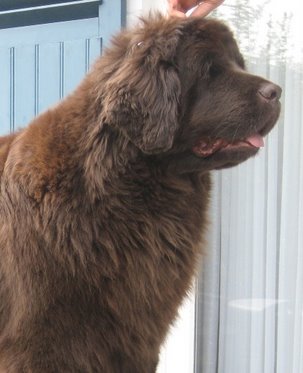
Training at home
It’s important to train and get your dog used to handling before you enter
the show ring. Newfoundlands are usually shows at a pose, with their heads
held up high and
legs positioned correctly. The show collar is usually a thin metal choke. It
is placed directly behind the ears and directly underneath the chin. With
that tightened, it’s easy to pull up the forehead to show an amazing stop.
The areas behind the ears are very sensitive, so to start with, the dog may
be anxious to get rid of it. However it will get used to it soon and is not
hurt in anyway using this method. The show collar position (right behind the
ears, under the chin) also allows better control of your dog, it can be used
in everyday situations.
The newfs legs must be positioned correctly. First the left front leg, then
the right frontleg. When they are positioned correctly, then it’s turn for
the left back leg and finally the right back leg. The frontlegs are
important to be positioned first, because if the are not in the correct
positions, the dog will more immediately when you start placing the back
legs.
The front legs are positioned by lifting the leg up from the shoulder and
just placing down. The leg will automatically drop into position underneath
the chest. The space between the front paws should be around 10-15cm
depending on the dog. The hind legs are much harder to position correctly,
but once you get the hang of it, you can do it to any dog. You have to try
and place them back enough, but not too much. It depends on the dog how far
you should put them and how apart. To make it easy: Place your hand on the
knee and lift up forwards, place the leg in a slight angle, as the leg would
normally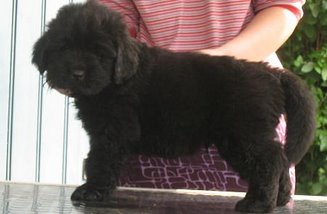 move, backwards. The legs should be placed a little wider than what the
width of the back is.
move, backwards. The legs should be placed a little wider than what the
width of the back is.
The best place to train the show stand is somewhere where you can see your reflection for example at the shop windows. A parking hall is also good, because the noises echo and smells are similar to indoor shows.
Not all dogs like being placed in the show position, so it’s important to start young and with lots of treats. A Newfoundland should stand still while the judge goes through the structure. The judge will check the bite and press and try the whole structure from the head and ear positions to the tail length. The judge will also check that the male dog’s testicles are correct, so remember to train that, because to an untrained dog, it will be a shock for the first time.
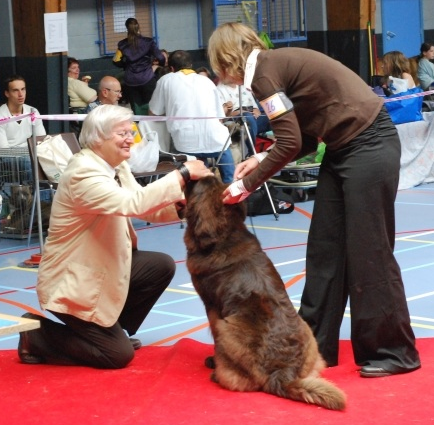 You
should practice checking the dog's bite. Some dogs do not like this, and it
is very difficult for the judge to check the teeth, if the dog is unwilling
(ie. backing away, moving all the time). As a hint for beginners, it is
easier to show the teeth if the dog is sitting down and thus has no chance
to back away. It is a technique which you can use with a young dog, but a
more experienced dog should be able to show the teeth while standing in the
correct show position.
You
should practice checking the dog's bite. Some dogs do not like this, and it
is very difficult for the judge to check the teeth, if the dog is unwilling
(ie. backing away, moving all the time). As a hint for beginners, it is
easier to show the teeth if the dog is sitting down and thus has no chance
to back away. It is a technique which you can use with a young dog, but a
more experienced dog should be able to show the teeth while standing in the
correct show position.
Before entering the show ring it is therefore important to train the show standing position and running at the correct pace. A newfoundland will always be shown to the judge, on the left side of the owner. The correct pace for a Newfoundland is a slow run, where the coat can move from side to side. It is NOT a speed race!
Match Shows (fun, non-serious shows) are excellent places to train your dog before “the real thing”. Some training clubs also organize show training sessions, where you can get hints for showing and the dog will get used to showing the bite, running behind, in front and between other dogs.
What should I take with me?
The best show collar is a thin silver metal choke chain. The leash should be
a thin, short, black one. These colours do not break the dog into pieces,
because they are similar to the dogs coat colour.
Take these with you:
+ Registration papers
+ Vaccination booklet
+ The show number (if the committee has sent it to you)
+ Driving instructions, and any other papers the committee might have sent you.
+ A receipt of payment
+ A number pouch (or pin with which you can clip it onto your chest)
+ Show collar and show leash
+ Brushes and combs for the final touch before the ring!
+
Water bowl and a bottle of water (you can always fill it up at the show)
These might also come in handy:
+ Food, treats, toy (no squeaky toys in to the show ring!)
+ A cage or a blanket for the dog to sleep on. Familiar blankets sometimes help the dog to stay calm and sleep amidst all the 'chaos'
+ A towel (for wiping the drool)
+ Doggybags!
+ A chair for you to sit on, so you don’t have to stand all day
+ A tent for outdoor shows? Trimming table?
+ Something for you to eat and drink. We always have a bottle of coke (caffeine!) and a chocolate bar (instant energy)
+Money for parking, for entry tickets ? for shopping?
Shows –the real thing
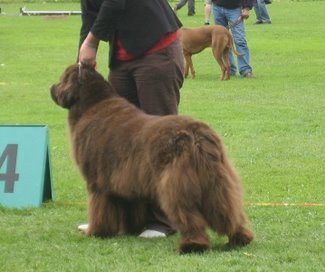 It’s
important for you to be early for the show, because you’ll never know what
delays there are on the way. The show ring also might be early; if you miss
your turn, you
won’t be judged. Usually however, the rings are late, so be prepared with a
lot of patience. It’s better for the dog if you can find a calm place to
wait in. Sometimes it’s better if you calm your dog before the ring,
sometimes it’s better to go in with a tired dog. It’ll take time before you
know what is best for it.
It’s
important for you to be early for the show, because you’ll never know what
delays there are on the way. The show ring also might be early; if you miss
your turn, you
won’t be judged. Usually however, the rings are late, so be prepared with a
lot of patience. It’s better for the dog if you can find a calm place to
wait in. Sometimes it’s better if you calm your dog before the ring,
sometimes it’s better to go in with a tired dog. It’ll take time before you
know what is best for it.
It is easiest and fastest to learn what happens just by going to several shows. If you aren’t sure of something, do ask the other competitors. Also the show committee and the ring secretary will be able to help you.
In the ring you do what the judge asks you to. A silent rule is to not speak to the judges unless you are spoken to. Usually the judges will ask the age. If you do not understand (a foreign judge..), then please do ask the ring secretary to translate. The dogs enter the ring in numerical order, by class. The judge usually takes everyone in the ring, lets them run a few laps and then starts looking at the dogs individually (bite, structure and gait). The judge will also ask you to run either around, a triangle or a straight line (remember to keep the dog on the judge’s side!). In some countries the judges will also give ribbons to show the quality rating. If not, then don’t worry, just take your place again at the end of the line and wait until the ring is over to know the judging.
After all the dogs have been individually judged, it’s time for the placing. Usually the four best dogs are places. In this the judge will usually put the dogs to a run again and will leave the best four in the ring. The judge will then place them. If you win or become second in your class, you will go ahead to the best male/best bitch ring, which is judged after all the male/bitch classes have been judged. The ring secretary will call you to the ring, but you should consider buying a catalogues so you know which dogs belong to your class. You may collect a written judgement or a placing certificate from the ring secretary after all the newfoundland classes are judged.
As a general rule you should act appropriately in shows, like in all other situations. You should accept the judges placings and critique, even if it does not coincide with your opinion. It is of good manners to congratulate the winners. You should not let your dog too close to the new other dogs since not all dogs might not be as social as yours. It is traumatic for a young dog if to get attacked, when they are only trying to be friendly.
Where to get information?
There are dozens of shows organized in every country every year. After you have picked the shows you want to attend, you should visit that country’s Kennel Club’s website to find all contact information and usually a show entry form. The entry fees depend on the type of shows, usually they are around 45€ per show per dog. Clubshows are shows for only a specific breed. In this case you should look for Newfoundland club shows. They usually attract breeders and a lot of breed enthousiasts. These shows are best is you want a specialist newfoundland judge opinion, or if you just want to see many newfoundlands under the same roof.
CAC shows are national shows. Usually the entry numbers are smaller, because
in these shows CACIBs won’t be awarded. CACIB shows are international shows,
where both CAC and CACIB are awarded to the best male and best bitch.
CACIBs account for the International Champion –title, CACs for national
Champions.
Once a year there is a Championship show in each country, in these, in
addition to CAC and CACIB, youth winner and winner tittles are awarded to
winners.
Just remember that everyone starts as a beginner, and you should always ask
if you are unsure of anything at all.
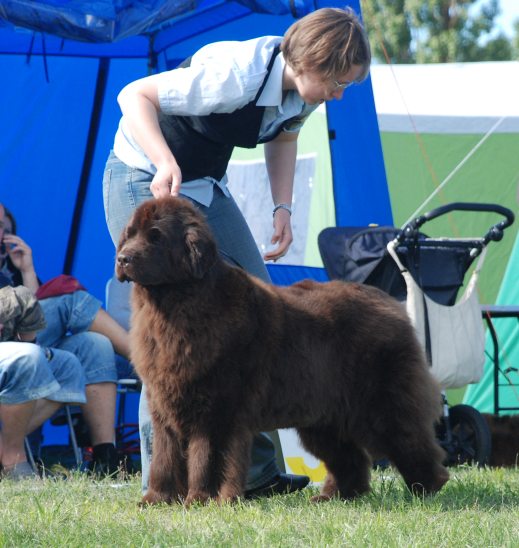
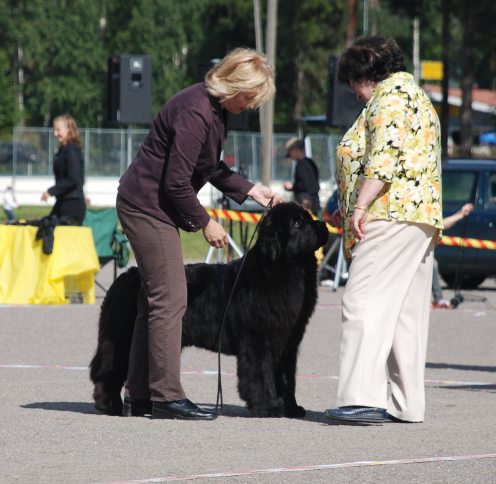
Our dogs' show-results:
Larinkallion Brysselinblicca "Capri"
Larinkallion Huomiongohde "Vera"
Kivisilmän Monitoimikone "Ruuti"
Events:
World Winner dogshow in Poland 2006
(c) Salmelin